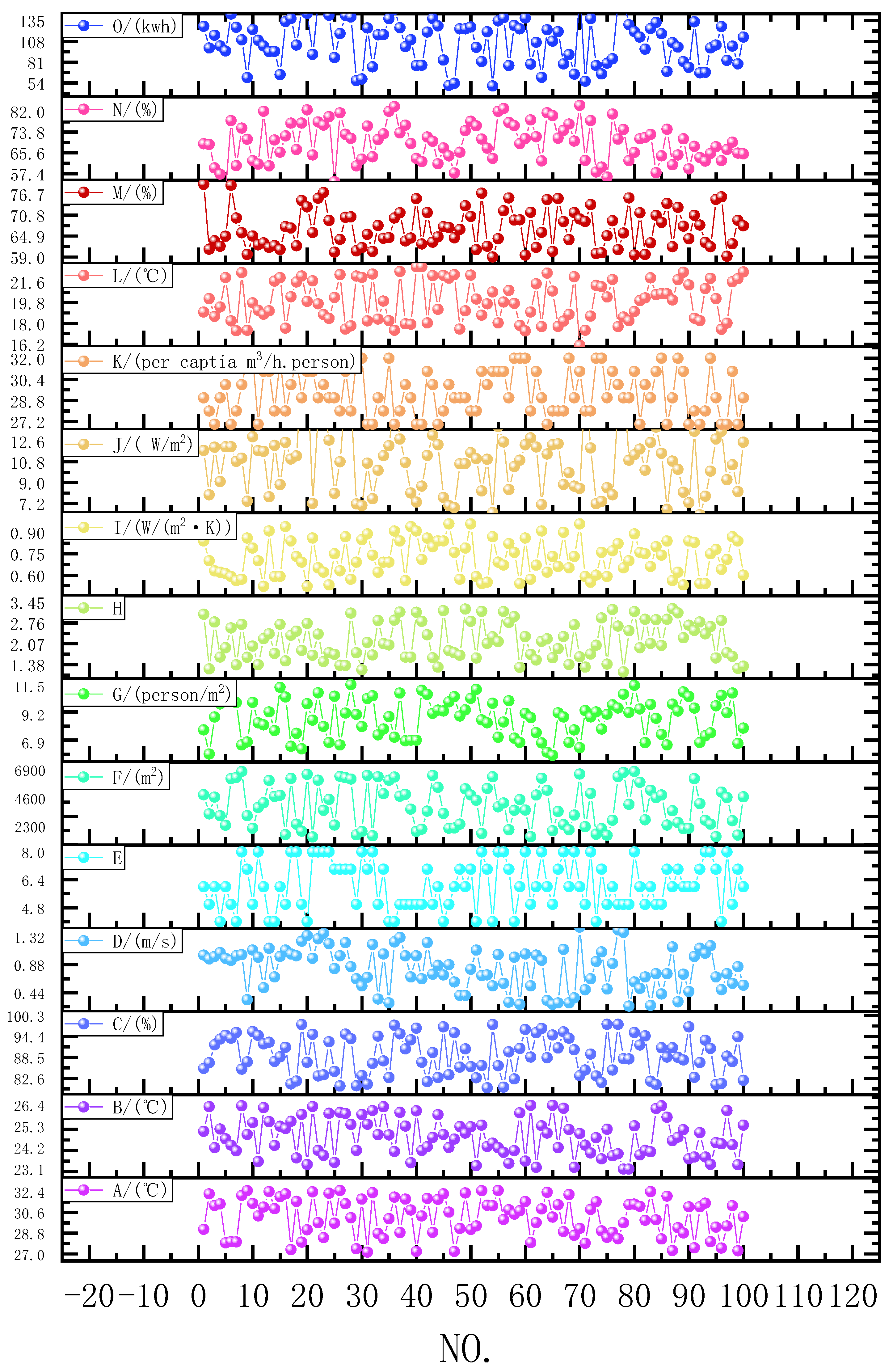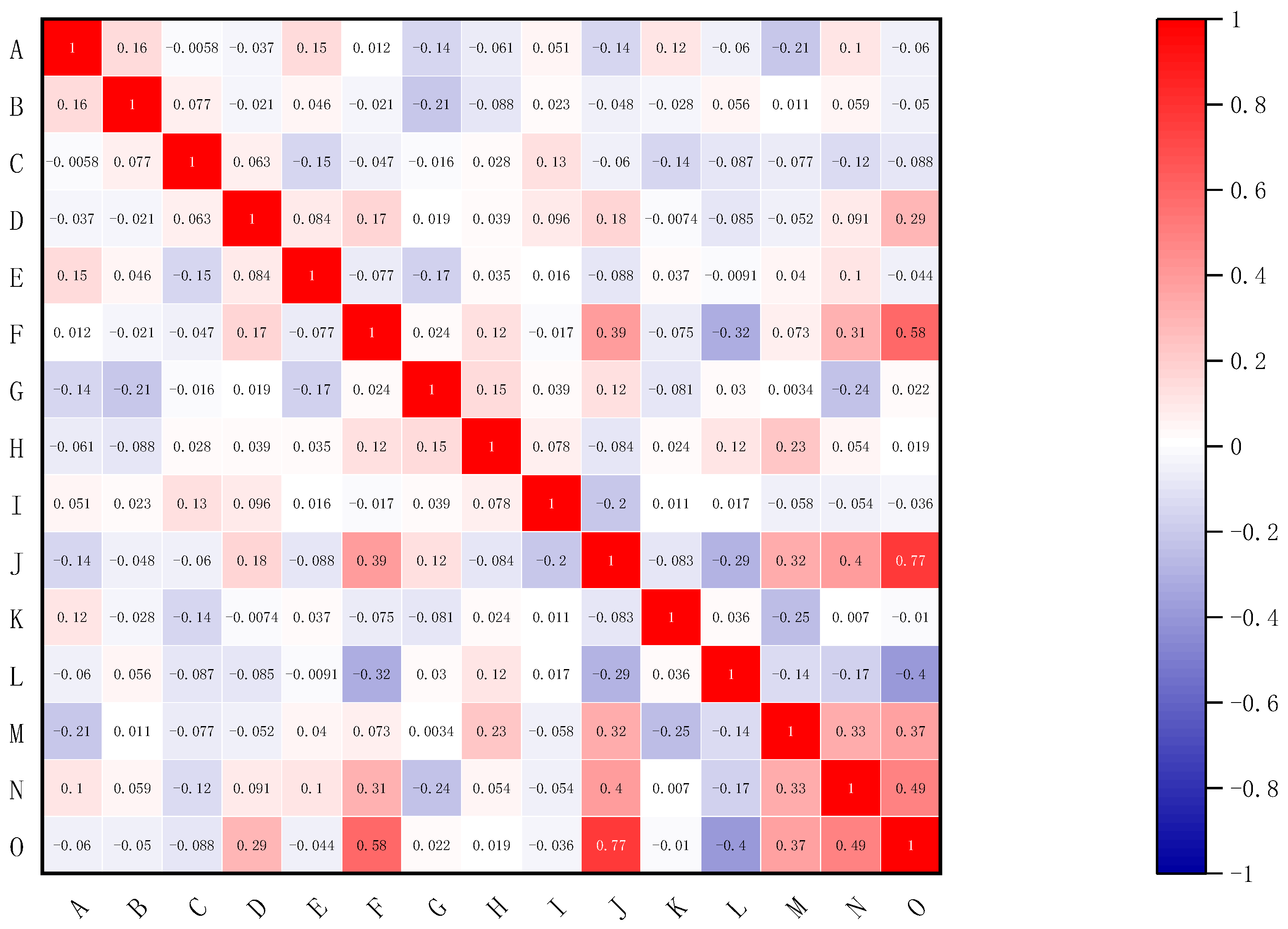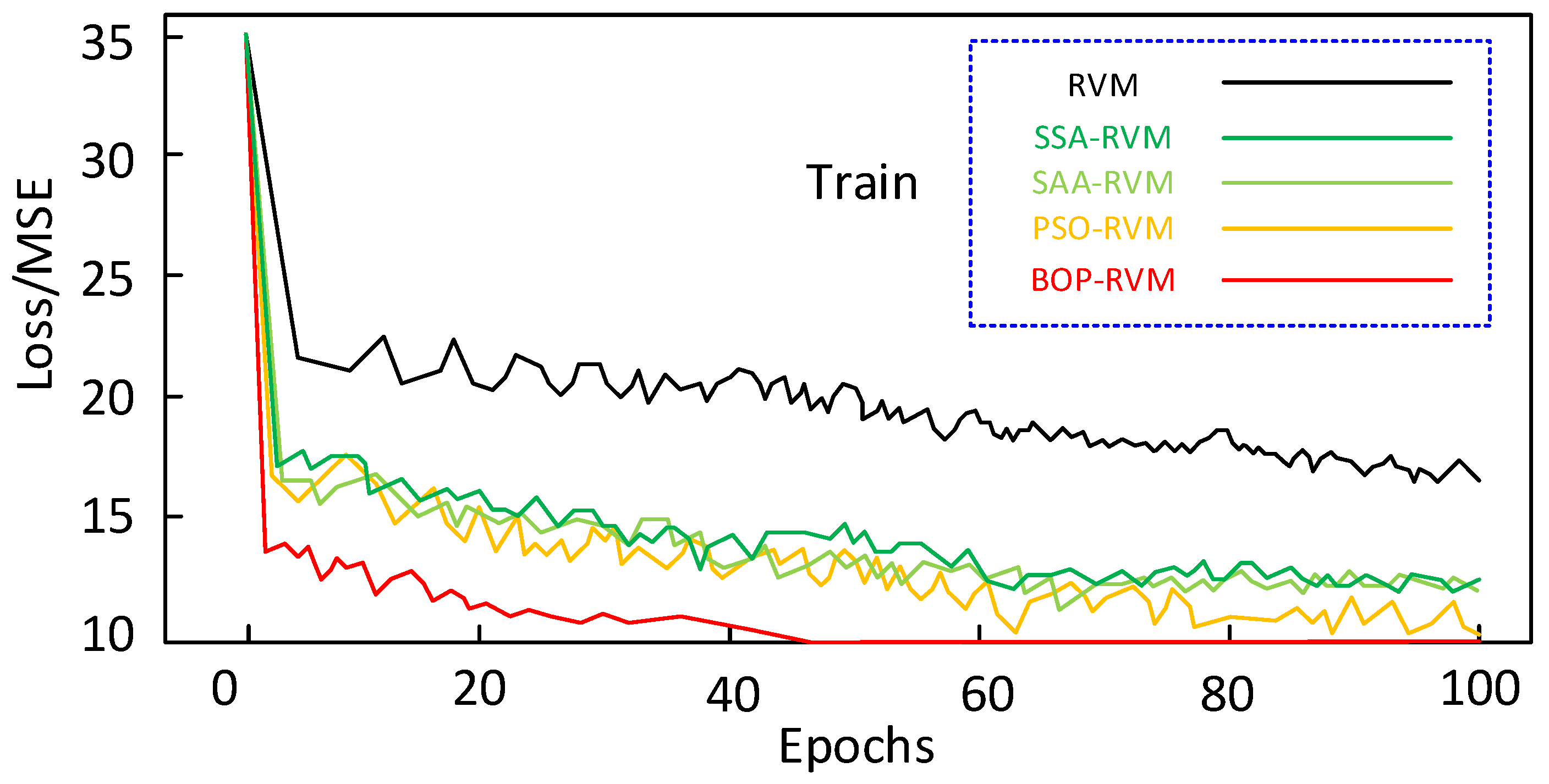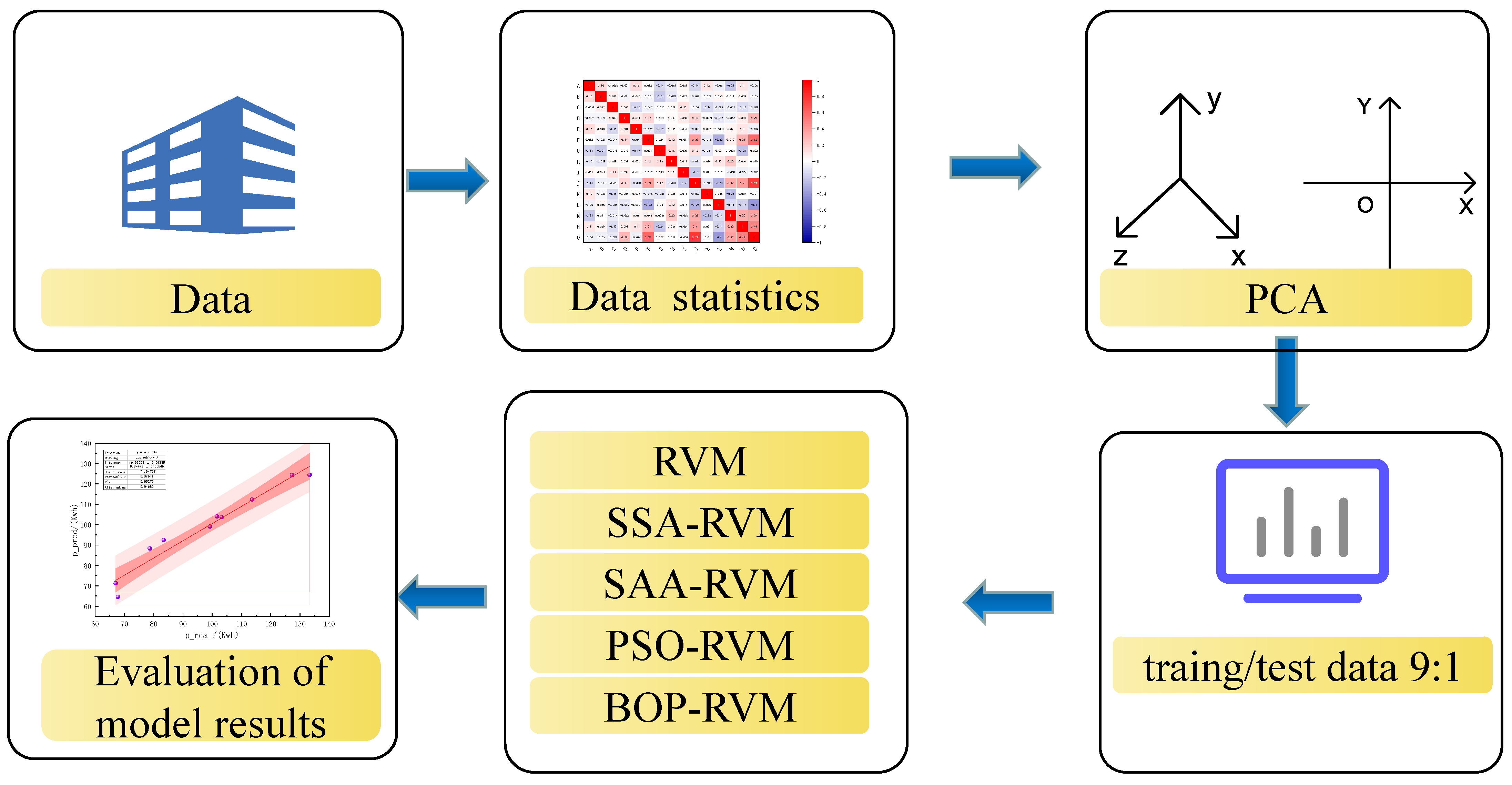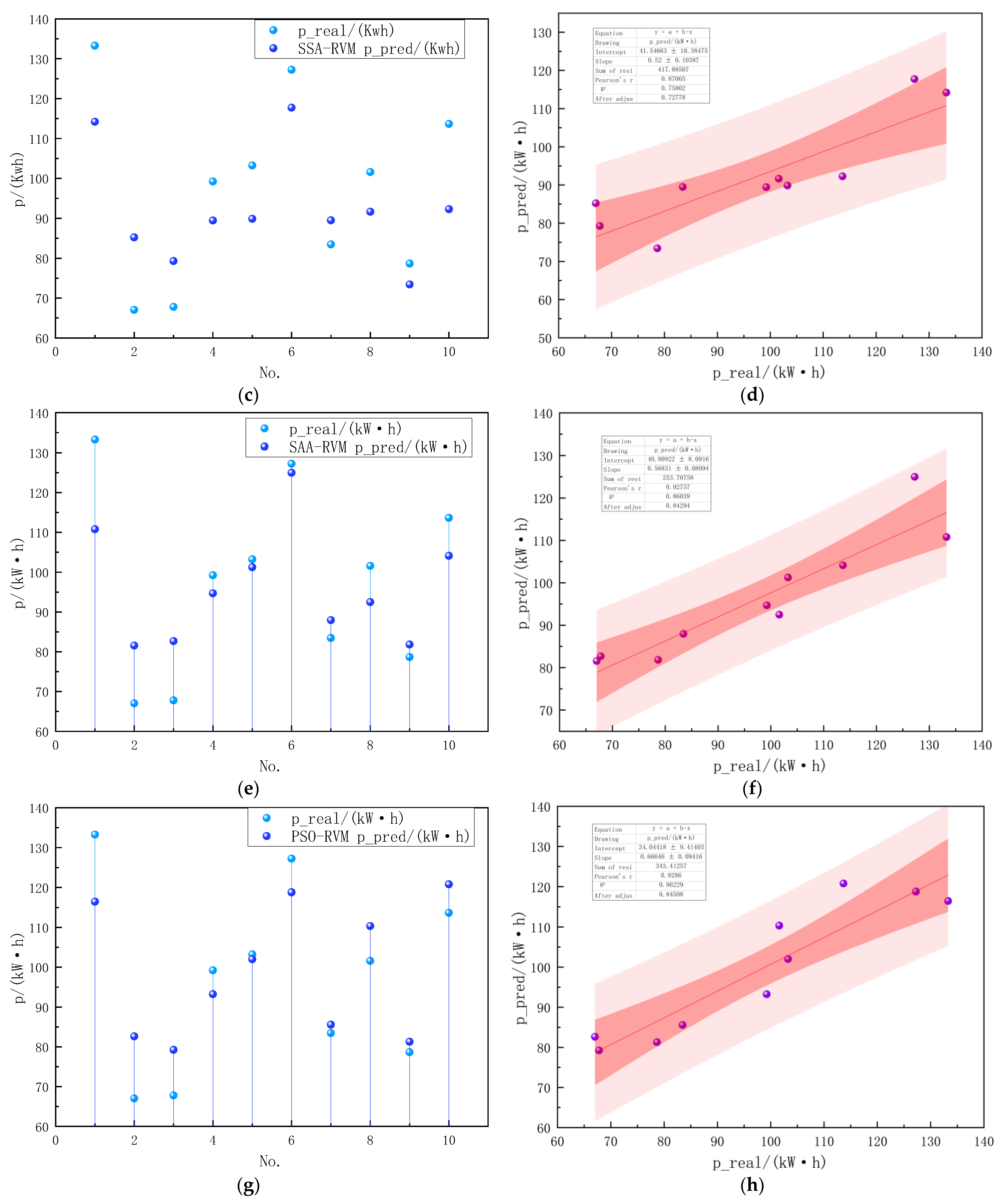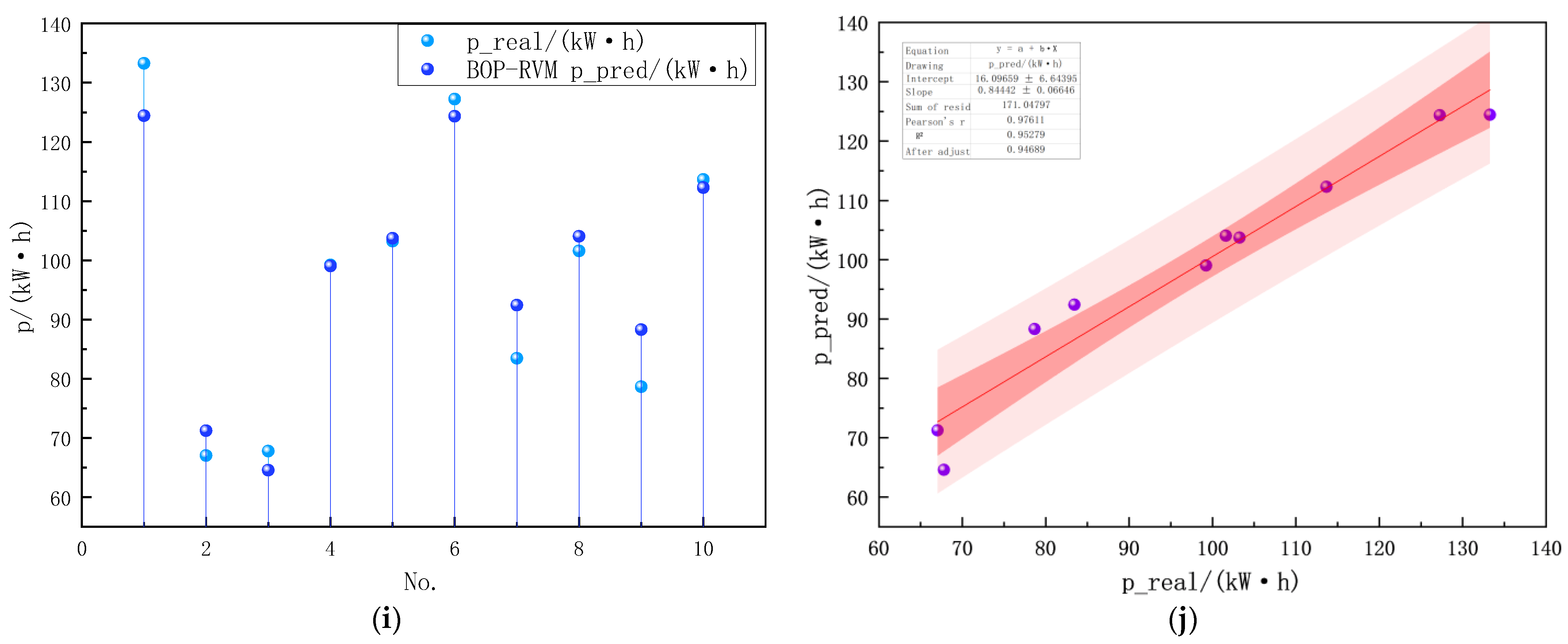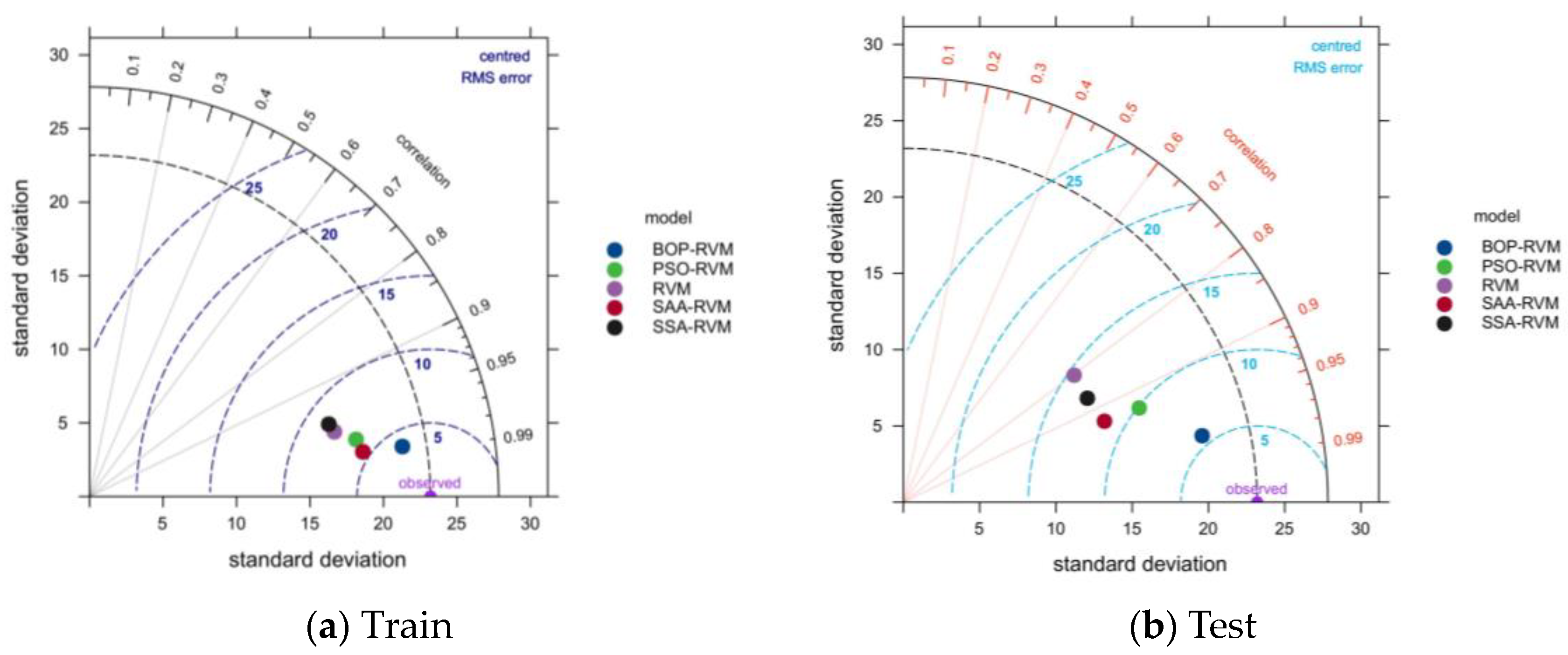3.1. Data Collection and Descriptive Analysis
This study primarily focuses on civil public buildings as the subject of experimentation. Data encompassing energy consumption values and influencing factors were collected from 100 civil public buildings in Wuhan during April 2022 under various energy consumption conditions. In 2022, Wuhan city recorded a permanent population of 13.739 million inhabitants, located between 113°41′–115°05′ longitude east and 29°58′–31°22′ latitude north. The city resides within the middle and lower reaches of the Yangtze River Plain, eastern Jianghan Plain, with an area of 8494 square kilometers. The 15 input variable indices include outdoor temperature, indoor temperature, relative humidity, wind speed, floor level, building area, personnel density, building aspect ratio, roof heat transfer coefficient, lighting power density, per capita fresh air volume, supply air temperature, fan efficiency, pump efficiency, with energy dissipation serving as the output scalar index. To facilitate subsequent analysis, these 15 variables are represented by alphabetic letters A through O for each variable level. The original data samples are shown in
Figure 1.
In addition, the descriptive statistics of 15 variables are given, such as minimum, maximum, mean, and standard deviation. The S-W normality test was performed on each variable, see
Table 1. Median: this is the value in the middle after sorting all observations. It is a measure of the central trend of the data and has good robustness to outliers. Average: this is the average of all observations. It is also a measure of the central trend of the data, but may be affected by outliers. Standard deviation: this is a measure of the average degree to which the observed value deviates from the average. The larger the standard deviation, the more dispersed the distribution of data. Skewness: this is a measure of the degree of asymmetry of data distribution. A negative skewness indicates that the data are skewed to the right, that is, there is a long left tail; a positive skewness indicates that the data are skewed to the left, that is, there is a long right tail. Kurtosis: this is a measure of the degree of sharp or flat data distribution. A negative kurtosis indicates that the distribution of the data is flatter than the normal distribution; a positive kurtosis indicates that the distribution of the data is sharper than the normal distribution. S-W test: this is the result of the Shapiro–Wilk test, which is used to test whether the data conform to a normal distribution. The first number in parentheses is the test statistic, and the second number is the
p-value. The results showed that using the S-W test, the significant
p value was 0.007 ***, the level was significant, the null hypothesis was rejected, and the data did not meet the normal distribution.
Preventing data redundancy, which refers to the unnecessary repetition of data, is crucial in modeling. One method to achieve this is by calculating the correlation coefficient between variables in the dataset. This technique identifies potential redundant characteristic variables and helps understand the correlation between different variables. For datasets not conforming to the normal distribution, as in this case, correlation analysis can be conducted using non-parametric tests or rank-based methods. These techniques are optimal because they do not make assumptions about the population’s distribution, as shown in
Figure 2.
The correlation coefficient ranges from −1 to 1. A coefficient of 0 indicates no relationship between the two variables. In contrast, a coefficient of 1 signifies a completely positive correlation between two variables, where an increase in one variable corresponds to an increase in the other. On the other hand, a coefficient of −1 suggests a completely negative correlation, meaning that the increase of one variable corresponds to the decrease of another variable. Upon examining the correlation between the input and output variables, it is apparent that there is a significant correlation between certain variables. The heat map of the variable correlation matrix reveals a high correlation between F, J, N, and O variables, with values ranging from 0.49 to a maximum of 0.77. The remaining variables show a lower correlation with the O variable. This analysis plays an essential role in ensuring the prediction accuracy of the model.
3.2. Dimensionality Reduction with PCA
Principal component analysis (PCA) is a multivariate statistical method that uses the idea of dimension reduction to recombine the original indicators with a certain correlation into a new set of comprehensive indicators without overlapping information under the premise of less information loss. At the same time, according to certain principles and actual needs, several comprehensive indicators are recombined to reflect the amount of information carried by most of the original indicators. The calculation steps of principal component analysis are as follows:
Step 1. Establish a
matrix, m is the number of samples,
n is the number of indicators for each sample.
Step 2. The original data are standardized to generate a standardized matrix. The standardized calculation formula is as follows:
where
is the arithmetic mean of
, and
is the standard deviation of
,
,
.
Step 3. KMO and Bartlett sphericity tests were performed. If the KMO statistic value is greater than 0.5, it can be seen that the correlation between variables is not much different, indicating that the data are suitable for factor analysis; the result of Bartlett’s spherical test is less than 0.05, the spherical hypothesis is rejected, and there is a correlation between the original variables, indicating that the data are suitable for factor analysis.
Step 4. The covariance matrix is established according to the standardized matrix. The covariance calculation formula is as follows:
where
,
.
The covariance matrix is composed of the covariance of two columns of variables in the standardized matrix, so is the correlation coefficient between column variables and , that is, the covariance matrix is the correlation coefficient matrix.
Step 5. Calculate the non-negative eigenvalue
of the covariance matrix
. The characteristic equation of covariance matrix is as follows:
Step 6. The cumulative contribution rate of the first
q principal component is calculated from the calculated p non-negative eigenvalue. The calculation formula is as follows:
Step 7. According to the cumulative contribution rate of principal components, the number of principal components is selected and new variable indicators are generated. When the cumulative contribution rate of the current principal component exceeds 85%, it can be considered that these principal components can contain most of the information carried by the overall. After generating the new variable index, it is used to represent the original variable index:
Among them, is the original variable index, is the new variable index, and are not related to each other, and satisfies. Thus, the data dimension reduction is completed, and the number of variables is reduced under the premise of less information loss.
As described above, the construction of a building energy consumption model, which leverages various optimization algorithms to optimize the relevance vector machine, involves selecting 15 variables as the key influencers of energy consumption. This collection of multiple factors composes the high-dimensional data, thereby increasing the complexity of model training. However, leveraging the core concept of principal component analysis (PCA), these original high-dimensional data can be more effectively mapped to a new low-dimensional space, while retaining as much of the original data information as possible. Although numerous factors impact energy dissipation, the model’s complexity is reduced by selecting the most critical principal component to lessen the number of features. The specific process of analysis is detailed in the following steps:
Step a: First, KMO and Bartlett tests are performed to determine whether principal component analysis can be performed. KMO test and Bartlett test can help to determine whether the data are suitable for factor analysis, and can help to select the best number of factors. Therefore, before factor analysis, KMO test and Bartlett test can improve the reliability and accuracy of factor analysis. The test results are shown in
Table 2.
The KMO test results showed that the KMO value was 0.455. At the same time, the results of the Bartlett spherical test showed that the significant p value was 0.000 ***, which was significant at the level, rejecting the original hypothesis. There was a correlation between the variables, and the principal component analysis was practical.
Step b: The principal component analysis (PCA) is a statistical procedure that transforms a number of possibly correlated variables into a smaller number of uncorrelated variables called principal components. It is essential when performing PCA to determine the number of principal components that should be retained to keep sufficient information and minimize dimensions. The variance interpretation table plays a key role in this determination. It is used to understand the degree to which each principal component contributes to the variance of the original variable, also known as the contribution rate. In general, only the principal components whose cumulative contribution rate reaches a certain threshold are retained. This threshold typically lies between 60% and 85%. The Scree plot, often referred to as the gravel map, aids in this process. It helps determine the number of principal components to retain, based on the size of their eigenvalues and the rate at which these eigenvalues decline. Here, the term eigenvalue, also referred to as the characteristic root within PCA or factor analysis, denotes the proportion of the total variance attributable to each principal component or factor. Principal components or factors with eigenvalues exceeding 1 are typically deemed significant as they explain greater variance than the average variance of an individual variable. The combination of these two methods helps to decide the final number of principal components that should be retained to achieve effective dimensionality reduction, as shown in
Table 3. The variance explained ratio represents the proportion of the total variance that each principal component or factor accounts for. This overall methodology ensures that the contribution rate of the principal components is high enough to provide meaningful insights.
When the principal component is 7, the characteristic root explained by the total variance is higher than 1, and the cumulative variance explanation rate is 66.106%. When the principal component is 8, the characteristic root of the total variance explanation is much lower than 1. This paper selects 7 principal component factors for data dimensionality reduction.
Step c: By analyzing the principal component load coefficient and the heat map, the importance of the hidden variables in each principal component can be analyzed, see
Table 4. The value of the factor loading coefficient is generally between −1 and 1. The larger the absolute value of the value, the stronger the correlation between the original variable and the corresponding principal component or factor. The negative load indicates that the relationship between the original variable and the principal component or factor is negatively correlated, while the positive load indicates a positive correlation.
Step d: Based on the principal component loading diagram, the multi-principal components are reduced to double principal components or three principal components, and the spatial distribution of the principal components is presented by quadrant diagram. In this paper, 7 principal components are reduced for the original sample dataset.
Step e: By analyzing the component matrix, the principal component formula and weight are obtained, see
Table 5.
Step f: Through principal component analysis, while reducing the dimension of variables, it also ensures that the amount of information carried by the original sample data is less lost. The comprehensive score after dimensionality reduction by principal component analysis is shown in
Table 6.
3.4. Model Training Results
Following the dimension reduction process detailed in
Section 3.2, the data were randomly organized. The first 90 data groups were selected as the training set, with the remaining 10 groups forming the test set. Using various optimization models, a building energy consumption prediction model was constructed to optimize the relevance vector machine. An analysis was performed on the characteristics of the predicted and actual values of each model. Additionally, each model’s capability to predict building energy dissipation was examined and quantified. As a result, the selection of the optimal prediction model has been achieved.
Upon completion of dimensionality reduction, 90 sets of training data were fed into the RVM model, SSA-RVM model, SAA-RVM model, PSO-RVM model, and BOP-RVM model for training. The optimal parameters obtained from
Section 3.3 were individually introduced into each model. Once the training was complete, the 10 test datasets were individually introduced into each of the aforementioned models for validation. By comparing the validation results with the energy consumption values in the original data, the optimal model was determined. The construction process of the building energy dissipation prediction model based on machine learning is shown in
Figure 4.
For the building energy dissipation prediction model, RVM model, SSA-RVM model, SAA-RVM model, PSO-RVM model, and BOP-RVM model are used to predict, respectively. The predicted results are shown in
Figure 5, which is the scatter diagram of the predicted value and the real value obtained by the four optimization models, and the regression analysis.
In
Figure 5b, the RVM model predicts the
R2 (0.6438) between the predicted value and the true value, and the fitting regression equation is (
ppred = 0.4826
preal + 43.5146); the model prediction accuracy is low. From
Figure 5a, we can see that the most obvious relative error values of the RVM model are samples 1 and 5, and the calculated maximum error is 20.83.
In
Figure 5c, after the SSA model parameter optimization, the error between the predicted value and the true value of sample 5 has been significantly reduced. The error of sample 5 is reduced from 20.83 kW·h to 13.38 kW·h, and the minimum error is only 5.25 kW·h. Although the relative error of samples 2 and 10 is greater than that of RVM model, the overall prediction result of SSA-RVM model is closer to the real value than that of RVM model. In
Figure 5d, the
R2 (0.758) between the predicted value and the real value is obtained by the SSA-RVM model prediction model; the fitting regression equation is (
ppred = 0.52
preal + 41.5466).
In
Figure 5e, after SAA model parameter optimization, the error between the predicted value and the true value of the sample 4–6 has been significantly reduced. The relative error of the model is below 10 kW·h, and the error of the sample 1 is 22.49 kW·h. The overall prediction results of the SSA-RVM model are closer to the true value than the RVM model. In
Figure 5f, the
R2 (0.8604) between the predicted value and the real value obtained by the SAA-RVM model prediction model, the fitting regression equation is (
ppred = 0.5683
preal + 40.8092).
In
Figure 5g, after the PSO model parameters are optimized, the overall prediction results of the PSO-RVM model are relatively stable. In
Figure 5h, the
R2 (0.8623) between the predicted value and the real value is obtained by the PSO-RVM model prediction model; the fitting regression equation is (
ppred = 0.6665
preal + 34.0442).
In
Figure 5i, after the BOP model parameters are optimized, the error between the predicted value and the true value of the samples 1–10 is significantly reduced. The relative error of the model is below 10 kW·h, and the error of the sample 8 is 9.65 kW·h. The overall prediction result of the BOP-RVM model is closer to the true value than other optimization models. In
Figure 5j, the
R2 (0.9528) is between the predicted value and the real value obtained by the BOP-RVM model prediction model; the fitting regression equation is (
ppred = 0.8444
preal + 16.0966).
With the construction of the model for the prediction of building energy dissipation, when we get the model’s predicted value, how to judge the deviation between the expected value and the measured value is also essential to research. Therefore, when evaluating the predictive value of the machine learning model, various evaluation indicators are selected, which can comprehensively reflect the performance of the constructed model. Root mean square error (
RMSE), coefficient of determination (
R2), correlation coefficient (
r), and Scatter Index (
SI) were used as indicators to measure the prediction effect of the model. RMSE is the most commonly used to measure the prediction effect of the regression model, which can better reflect the deviation between the predicted value and the actual value. For RMSE [0, ∞), the smaller the value, the better the prediction effect.
R2 represents the extent to which the regression model can explain the change of the target variable and reflect the model’s goodness of fit. For
R2 (−∞, 1], the larger the
R2, the better the fitting. If it is negative, the prediction effect of the regression model is not as good as the average value of the target variable.
r represents the degree of linear correlation between the predicted value and the real value,
r [−1, 1]; the more significant the absolute value, the more substantial the correlation, and the higher the degree of model matching.
where
ppred is the predicted energy dissipation prediction value,
preal is the observed energy dissipation,
is the average predicted energy dissipation, and
is the average observed energy dissipation,
is the standard deviation of the prediction error,
is the average value of the true value. The evaluation results of each model are shown in
Table 8. Comparing the prediction accuracy of the four optimization models and the RVM model, it is found that the optimization model can better improve the prediction accuracy of building energy dissipation. The BOP-RVM model has the highest model prediction accuracy and can better improve the accuracy between the predicted value and the actual value.
Based on
Table 7 results, it was observed that the RVM model performed worst among all indicators. The model’s coefficient of determination is only 0.6438, indicating that the model has a limited ability to interpret the observed data. The linear correlation value is 0.8024, which shows that the linear correlation between the model and the observation data is weak. At the same time, the root mean square error reaches 23.1517, which means that the model’s prediction accuracy is relatively low. Therefore, from the perspective of all-around performance, the fitting effect and prediction ability of the RVM model could be better.
In comparison to the standalone RVM model, the other four models—namely BOP-RVM, SAA-RVM, PSO-RVM, and SSA-RVM—showcase superior performance. Among them, the BOP-RVM model stands out with impressive scores in key metrics: determination coefficient (0.9528), linear correlation value (0.9761), and root mean square error (5.3894). These statistics reveal that the BOP-RVM model not only explains the changes in observation data exceptionally well but also boasts high prediction accuracy.
Following closely are the SAA-RVM and PSO-RVM models, demonstrating robust overall performance. The SAA-RVM model achieves a determination coefficient of 0.9276, a linear correlation value of 0.8604, and a root mean square error of 9.6136. Meanwhile, the PSO-RVM model obtains a determination coefficient of 0.8623, a linear correlation value of 0.9286, and a root mean square error of 9.6395. Both models manage to provide compelling explanations for the observed data and maintain high prediction accuracy.
The SSA-RVM model, however, ranks in the middle of the pack in terms of overall performance, with a determination coefficient of 0.7580, a linear correlation value of 0.8707, and a root mean square error of 13.9313. Despite its reasonable fitting effects and prediction accuracy, it still falls short when compared to other models.
To provide a more comprehensive comparison, we introduced the Taylor diagram as a tool to evaluate the prediction accuracy of each model (refer to
Figure 6). The diagram indicates that the BOP-RVM model sits closest to the observed point, signifying its superior prediction accuracy among the five models.
Focusing on the performance metrics within the training set, all models exhibit a high level of predictive accuracy. In fact, the standard deviation, root mean square error, and correlation coefficients closely approximate the observed distances. However, when the models are applied to the test set, which consists of different data than the training set, discrepancies emerge. In this scenario, the optimized RVM models, particularly the BOP-RVM, outshine the standalone RVM model across all three evaluation metrics. This observation underscores the BOP-RVM model’s superior performance in both training and test settings, thus affirming its potential for future applications.
In summary, by comparing and analyzing the performance indicators of each model, it is found that the BOP-RVM model performs best in comprehensive performance, with a high determination coefficient, linear correlation value, and low root mean square error. Secondly, SAA-RVM and PSO-RVM models perform well in all-around performance. The SSA-RVM model ranks in the middle, while the RVM model performs worst among all indicators.
